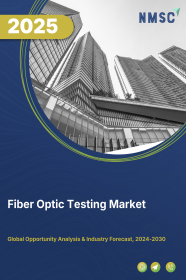
Fiber Optic Testing Market by Form (Bench Top & Rack Mounted and Portable & Handheld), by Fiber Mode (Single Mode and Multimode), by Product Type (Optical Time Domain Reflectometers (OTDR), Optical Light Source (OLS), Optical Power Meter (OPM), Optical Loss Test Set (OLTS), Remote Fiber Test Systems (RFTS), Optical Spectrum Analyzer (OSA), and Others), and Others - Global Opportunity Analysis and Industry Forecast 2022-2030
US Tariff Impact on Fiber Optic Testing Market
Trump Tariffs Are Reshaping Global Business
Market Definition:
The Fiber Optic Testing Market size was estimated at USD 285 million in 2021 and is expected to garner USD 570.7 million with a CAGR of 8.1% from 2022 to 2030.
Fiber optics refers to the technology that transmits information as light pulses along a glass or plastic fiber. Whereas, fiber optic testing is a way to examine functionality and characteristics such as performance, troubleshooting, and splicing of the fiber optic components, fiber links, and deployed fiber networks. This test comprises optical and mechanical testing as well as overall transmission tests for validating the integrity of fiber optic installations. Fiber optics test ensures longevity, minimizes system downtime, reduces maintenance needs, and supports system upgrades & reconfigurations. All these features of fiber optics contribute significantly to delivering network performance, reliability, and manageability.
Market Dynamics and Trends:
Increasing demand for high-speed fiber optics networks and adoption of 5G network as internet provided through the fiber is faster and more reliable, which creates lucrative growth for the market across the globe. Also, rapid growth in the telecommunication industry as fiber optics provides higher bandwidth allowing more data to be delivered efficiently driving the growth of the market.
Moreover, rising 5G infrastructure is transforming the realm of various broadband services by enabling connectivity across numerous end-user verticals. Notably, governments across the globe are implementing smart city projects with fiber optic networks to ensure the sleek flow of Internet of Things (IoT) infrastructure. For instance, according to the GSMA, 5G networks are likely to cover one-third of the world’s population. 5G Networks will adapt to various applications and performance will be tailored precisely to the needs of the user.
However, poor technical expertise along with the high cost of installation are the factors restraining the growth of the market during the forecast period. On the contrary, technological advancement such as real-time 100 gig and 40 gig network installations that creates a trend for high fiber optic performance is expected to create ample growth opportunities for the market in the coming years.
Market Segmentations and Scope of the Study:
The fiber optic testing market is segmented on the basis of form, fiber mode, product type, service type, offering type, equipment type, application, end-users, and geography. On the basis of form, the market is divided into bench top & rack mounted and portable & handheld. On the basis of fiber mode, the market is classified into single mode and multimode. On the basis of product type, the market is categorized into optical time domain reflectometers (OTDR), optical light sources (OLS), optical power meters (OPM), optical loss test sets (OLTS), remote fiber test systems (RFTS), optical spectrum analyzer (OSA) and others. On the basis of service type, the market is segmented into certification services, inspection services, testing services, and other services. On the basis of offering type, the market is divided into in-house service and outsourced service. On the basis of equipment type, the market is classified into optical light sources, optical power & loss meters, optical time domain reflectometers, optical spectrum analyzers, remote fiber test systems, and others. On the basis of application, the market is segmented into installation, manufacturing, and research. On the basis of end-users, the market is categorized into telecommunication, cable television, aerospace & defense, railway, oil & gas, energy & power, data centers, industries, and others. Geographic breakdown and analysis of each of the aforesaid segments include regions comprising of North America, Europe, Asia-Pacific, and RoW.
Geographical Analysis:
Asia-Pacific holds the lion’s share of fiber optic testing market trends during the forecast period. This is attributed to factors such as the rapid rise in data centers that shared IT operations and equipment for the purpose of storing, processing, and disseminating data and applications has resulted in the consumption of high-speed fiber optics. Moreover, increasing government initiatives by various countries boost the market growth in this region. For instance, in August 2022, RIL India launched Stand-Alone 5G JioAirFiber. This will be the world’s largest and most advanced 5G network and it has zero dependencies on Jio’s 4G network. Jio has made strong progress in fiber and FTTH deployment with a pan-India fiber-optic network of more than 11 lakh route kilometers.
On the other hand, North America is expected to show a steady rise in the fiber optic testing market due to the widespread use of broadband subscription facilities that run on fiber optics to provide high-speed internet speed to boost the market growth in this region. Also, the presence of key players in the market such as VIAVI Solutions, EXFO, and VeEX Inc are expected to drive the fiber optic testing market growth in this region.
For instance, in March 2022, VeEX Inc. had announced the RXT-6402, which is a third-generation advanced multi-service 400G test set. The RXT-6402 module and RXT-1202 high-power chassis are based on the latest generation of flexible and state-of-the-art FPGA technology. This increases efficiency and ease of use for FAEs & installation and maintenance crews working on large equipment rooms, data centre clusters, or customer premises.
Competitive Landscape:
The fiber optic testing market comprising of various market players such as VIAVI Solutions, EMCORE, AFL, Anritsu Corporation, EXFO Inc, Fluke Networks, GAO Group Inc, Kingfisher International PTY Ltd, Multicom Inc and VeEX Inc.
These market players are adopting various joint venture strategies and planning expansion of business across various regions to maintain their dominance in the fiber optic testing market.
For instance, in February 2022, EMCORE announced to acquire L3Harris to expand its fiber optic gyroscope (FOG) product portfolio along with the development and production of high-performance such as FOGs, Ring Laser Gyros (RLGs), and reaction wheels.
Moreover, for instance, in June 2021, VIAVI Solutions announced to the expansion of its capabilities in fiber testing and monitoring portfolio in the high-speed core, metro ring networks, passive optical network (PON) 5G, and data center networks.
Key Benefits
-
The fiber optic testing market report provides the quantitative analysis of the current market and estimations through 2022-2030 that assist in identifying the prevailing market opportunities to capitalize on.
-
The study comprises a deep dive analysis of the fiber optic testing market trend including the current and future trends for depicting the prevalent investment pockets in the market.
-
The information related to key drivers, restraints, and opportunities and their impact on the fiber optic testing market is provided in the report.
-
The competitive analysis of the market players along with their market share in the fiber optic testing market.
-
The SWOT analysis and Porter’s Five Forces model is elaborated in the study.
-
Value chain analysis in the market study provides a clear picture of the stakeholders’ roles.
Key Market Segments:
By Form
-
Bench Top & Rack Mounted
-
Portable & Handheld
By Fiber Mode
-
Single Mode
-
Multimode
By Product Type
-
Optical Time Domain Reflectometers (OTDR)
-
Optical Light Source (OLS)
-
Optical Power Meter (OPM)
-
Optical Loss Test Set (OLTS)
-
Remote Fiber Test Systems (RFTS)
-
Optical Spectrum Analyzer (OSA)
-
Others
By Service Type
-
Certification Services
-
Inspection Services
-
Testing Services
-
Other Service
By Offering Type
-
In-House Service
-
Outsourced Service
By Equipment Type
-
Optical Light Sources
-
Optical Power & Loss Meters
-
Optical Time Domain Reflectometer
-
Optical Spectrum Analyzers
-
Remote Fiber Test System
-
Others
By Application
-
Installation
-
Manufacturing
-
Research
By End-Users
-
Telecommunication
-
Cable Television
-
Aerospace & Defense
-
Railway
-
Oil & Gas
-
Energy & Power
-
Data Centers
-
Industries
-
Others
By Geography
-
North America
-
U.S
-
Canada
-
Mexico
-
-
Europe
-
UK
-
Germany
-
France
-
Italy
-
Spain
-
Rest of Europe
-
-
Asia-Pacific
-
China
-
India
-
Japan
-
South Korea
-
Australia
-
Rest of Asia-Pacific
-
-
RoW
-
UAE
-
Saudi Arabia
-
South Africa
-
Brazil
-
Remaining Countries
-
Key Players
-
VIAVI Solutions
-
EMCORE
-
AFL
-
Anritsu Corporation
-
EXFO Inc
-
Fluke Networks
-
GAO Group Inc
-
Kingfisher International PTY Ltd
-
Multicom Inc
-
VeEX Inc.

















 Speak to Our Analyst
Speak to Our Analyst



















